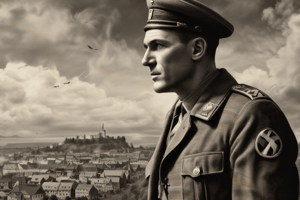Podcast
Questions and Answers
What was the main military strategy used by Germany during the invasion of Poland in 1939?
What was the main military strategy used by Germany during the invasion of Poland in 1939?
Blitzkrieg or Lightning War
Which two major countries declared war on Germany after the invasion of Poland?
Which two major countries declared war on Germany after the invasion of Poland?
France and Great Britain
What was the purpose of the nonaggression pact signed between Hitler and Stalin?
What was the purpose of the nonaggression pact signed between Hitler and Stalin?
To prevent the Soviet Union from joining the Allies
What defensive line did the French prepare along their border with Germany?
What defensive line did the French prepare along their border with Germany?
Which country resisted the Soviet Union's attempts to take over and fought for almost 6 months?
Which country resisted the Soviet Union's attempts to take over and fought for almost 6 months?
What was the Siegfried Line and how long was it?
What was the Siegfried Line and how long was it?
Why was the period from September 1939 to March 1940 referred to as 'The Phony War'?
Why was the period from September 1939 to March 1940 referred to as 'The Phony War'?
How did Hitler invade Denmark and Norway?
How did Hitler invade Denmark and Norway?
What strategic advantage did Hitler gain by establishing bases on the coasts of Denmark and Norway?
What strategic advantage did Hitler gain by establishing bases on the coasts of Denmark and Norway?
Describe the evacuation of Dunkirk in 1940.
Describe the evacuation of Dunkirk in 1940.
Study Notes
Hitler's Nonaggression Pact with Stalin
- Hitler signed a nonaggression pact with Stalin, promising not to attack the Soviet Union.
- In return, Stalin was allowed to spread communism in Eastern Europe, including Finland, and the Baltic countries of Lithuania, Latvia, and Estonia.
- Hitler was free to concentrate his troops on the Western border, and Stalin promised not to join the Allies.
Blitzkrieg – Invasion of Poland
- Hitler attacked Poland on September 1, 1939, using the new military strategy of Blitzkrieg or Lightning War.
- Blitzkrieg involved fast-moving airplanes and tanks, followed by massive infantry forces.
- France and Great Britain declared war on Germany on September 3, 1939.
- Poland surrendered a month after the attack.
The Phony War
- From September 1939 to March 1940, there was a period of inactivity, known as the Phony War.
- Hitler launched an invasion of Denmark and Norway, which fell in 4 hours and 2 months, respectively.
- Hitler established bases on their coasts to attack Great Britain.
The Fall of France
- In May 1940, Hitler sent Nazi troops through the Netherlands and the Ardennes to conquer France.
- Nazi troops reached the northern coast of France in just 10 days.
- Outnumbered, outgunned, and pounded from the air, the Allies (British and French troops) retreated to the beaches of Dunkirk.
- Britain sent boats, ships, and yachts to evacuate around 338,000 soldiers to Great Britain.
- France surrendered on June 22, 1940.
Evacuation of Dunkirk and Vichy France
- The Germans took control of the northern part of France.
- The southern part, Vichy France, was governed by a puppet government set by the Germans.
Studying That Suits You
Use AI to generate personalized quizzes and flashcards to suit your learning preferences.
Description
Learn about the nonaggression pact signed between Hitler and Stalin, where Hitler promised not to attack the Soviet Union, dividing Poland, and allowing the spread of Communism in eastern Europe. Stalin, in return, promised not to join the Allies, allowing Hitler to focus his troops on the western front.




